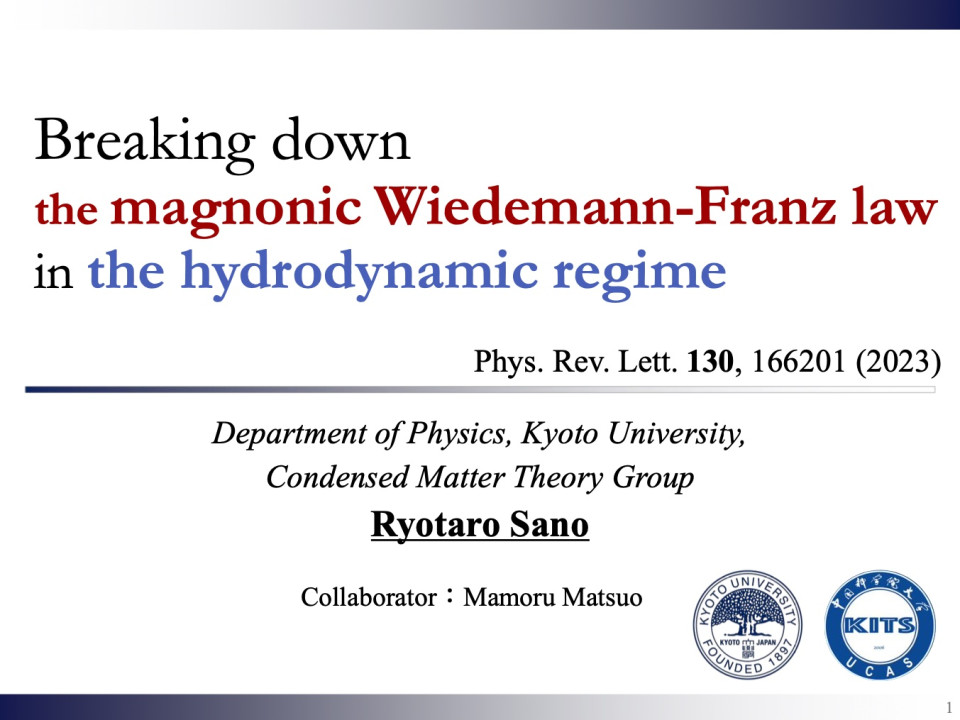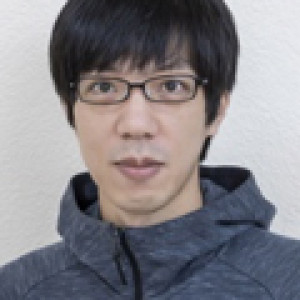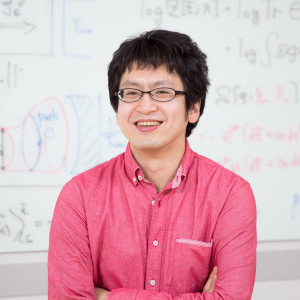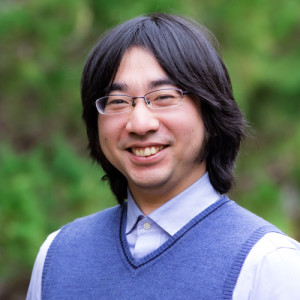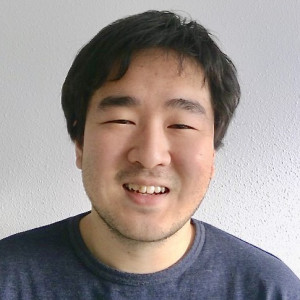Volume 282
Back to Newsletter List
Press Release
Black Hole Recorder Selected for DIG SHIBUYA Art Event Co-Sponsored by Shibuya Ward
2023-12-20
The science art piece "Black Hole Recorder," created in 2021 by iTHEMS in collaboration with external creators based on the quantum black hole theory, has been selected for the collaborative project (open call) of the "DIG SHIBUYA" art event, co-hosted by the SHIBUYA CREATIVE TECH Executive Committee and Shibuya Ward. As part of the program within "DIG SHIBUYA," the artwork is scheduled for exhibition at the Shibuya Ward Workers' Welfare Hall from January 12th (Friday) to January 14th (Sunday), 2024, spanning three days.
For more information, please see the related links.
Seminar Report
iTHEMS Theoretical Physics Seminar by Ryotaro Sano on December 4, 2023
2023-12-18
In this seminar, Mr. Sano presented their study on magnon hydrodynamics for ultraclean ferromagnets. A set of coupled hydrodynamic equations for a magnon fluid are derived and the spin and thermal conductivities are studied by focusing on the most dominant time scales.
As a hallmark of the hydrodynamic regime, the speaker and his colleagues reveal that the ratio between the two conductivities shows a large deviation from the so-called magnonic WF law. The drastic breakdown of the magnonic WF law results from the difference in relaxation processes between spin and heat currents, which is unique to the hydrodynamic regime. Therefore, the presented results will become key evidence for an emergent hydrodynamic magnon behavior and lead to the direct observation of magnon fluids. In the seminar, researchers with different backgrounds (ranging from condensed matter physics to nuclear physics and cosmology) asked a lot of questions, and a lively discussion ensued.
Reported by Yuta Sekino
Breaking down the magnonic Wiedemann-Franz law in the hydrodynamic regime
December 4 (Mon) 15:00 - 16:30, 2023
Upcoming Events
Seminar
Quantum Matter Seminar
A symmetry principle for gauge theories with fractons
December 22 (Fri) 17:00 - 18:15, 2023
Yuji Hirono (Program-Specific Associate Professor, Department of Physics, Division of Physics and Astronomy, Graduate School of Science, Kyoto University)
Fractonic phases are emergent quantum phases of matter that host excitations with restricted mobility. Although these phases have been considered to be of “beyond Landau” order, we show that a certain class of gapless fractonic phases are realized as a result of spontaneous breaking of generalized symmetries. The corresponding symmetries are continuous higher-form symmetries whose conserved charges do not commute with spatial translations, and we refer to them as nonuniform higher-form symmetries. For a given set of nonuniform symmetries, the effective theory associated with the spontaneous breaking of them can be constructed. At low energies, the theories reduce to known higher-rank gauge theories such as scalar/vector charge gauge theories, and the gapless excitations in these theories are interpreted as Nambu–Goldstone modes for higher-form symmetries. Due to the nonuniformity of the symmetry, some of the modes acquire a gap, which is the higher-form analogue of the inverse Higgs mechanism of spacetime symmetries. In this formulation, the mobility restrictions are fully determined by the choice of the commutation relations of charges with translations. This approach allows us to view existing (gapless) fracton models such as the scalar/vector charge gauge theories and their variants from a unified perspective and enables us to engineer theories with desired mobility restrictions.
Field: condensed matter physics
Keywords: fractonic phases, higher-form symmetries, Nambu-Goldstone modes, Higgs mechanism, gauge theories
Reference
- Yuji Hirono, Minyoung You, Stephen Angus, Gil Young Cho, A symmetry principle for gauge theories with fractons, arXiv: 2207.00854
Venue: via Zoom
Event Official Language: English
Lecture
RIKEN Quantum Lecture
Rapid development of cold-atom quantum computers and their prospect
December 26 (Tue) 13:30 - 17:00, 2023
Takafumi Tomita (Assistant Professor, Photo-Molecular Science, Institute for Molecular Science)
Note for participants:
For on-site participants, please register via the registration form.
For online participants finding the Zoom link, you can get it after filling the registration form.
Program:
13:30-15:00 Lecture 1
15:00-15:30 Coffee break
15:30-17:00 Lecture 2
Abstract:
In this talk, I will give an overview of the recent rapid progress of cold-atom quantum computers. In a cold-atom quantum computer, a laser-cooled atomic gas in a vacuum chamber is captured with a two-dimensional trap array called an optical tweezers array, which is an array of tightly focused laser beams. An array of cold single atoms thus created is initialized, gate operated, and readout with other laser beams. Because of its controllability and scalability, the cold-atom quantum computer has been attracting much attention, as one of the most promising candidates in the race to develop quantum-computer hardware. I will describe the characteristics and development trends of the cold-atom hardware, as well as the development of a cold-atom quantum computer at Institute for Molecular Science including the realization of an ultrafast quantum gate using ultrashort laser pulses.
Venue: #435-437, 4F, Main Research Building, RIKEN Wako Campus / via Zoom
Event Official Language: English
Seminar
iTHEMS Biology Seminar
Oscillatory data analysis using the extended Hilbert transform method
December 26 (Tue) 16:00 - 17:00, 2023
Akari Matsuki (Postdoctoral Researcher, Department of Advanced Transdisciplinary Sciences, Hokkaido University)
Oscillatory phenomena are observed in various biological systems, such as spinal nervous systems and circadian rhythms. These macroscopic oscillatory phenomena appear as a result of synchronization of microscopic oscillators, such as pacemaker cells. The first step in the analysis of synchronization is to reconstruct the "phase" from the observed signal. The Hilbert transform method is one of the popular methods for phase reconstruction, but it is known that it can only accurately reconstruct the phase from a limited class of signals such as narrowband signals. In this study, we show that the Hilbert transform method has a low-pass filter-like effect on the phase modulation and propose an "extended Hilbert transform method" that can be applied to a wider class of signals.
In this talk, I will introduce the extended Hilbert transform method, and its application to phase shift detection and coupling network inference.
Reference
- Akari Matsuki, Hiroshi Kori, Ryota Kobayashi, An extended Hilbert transform method for reconstructing the phase from an oscillatory signal, Scientific Reports, 13, 3535 (2023), doi: 10.1038/s41598-023-30405-5
Venue: via Zoom
Event Official Language: English
Lecture
Introduction to Effective Field Theory and Many-Body Problems
December 27 (Wed) - 28 (Thu) 2023
Masaru Hongo (Assistant Professor, Department of Physics, Faculty of Science, Niigata University)
Quantum field theory (QFT) has been formulated as a theoretical tool to describe elementary particles and nuclei. However, after introducing the concept of "effective field theory," QFT has been providing a general and powerful theoretical framework for describing various universal phenomena in broader range of physical systems, including condensed matter physics and statistical physics.
In this lecture, we will explore the basic aspects of field theory by employing it to address quantum many-body problems in simple nonrelativistic systems.
The topics covered will include:
Lecture 1: Low-energy scattering and renormalization in quantum mechanics
Lecture 2: Effective field theory of low-energy scattering
Lecture 3: Spontaneous symmetry breaking in weakly-interacting bose gas
Lecture 4: Effective field theory of superfluid
Lecture 5: Introduction to in-medium potential
Lecture 6: Complex-valued in-medium potential between heavy impurities in ultracold atoms
The aim is to provide an introductory overview and explanation of basics concepts in field theory.
Schedule:
Wed., Dec. 27
10:00 - 11:30: Lecture 1
13:00 - 14:30: Lecture 2
15:00 - 16:30: Lecture 3
Thur., Dec. 28
10:00 - 11:30: Lecture 4
13:00 - 14:30: Lecture 5
15:00 - 16:30: Lecture 6
Venue: Hybrid Format (3F #359 and Zoom), Main Research Building, RIKEN Wako Campus
Event Official Language: English
Seminar
Math-Phys Seminar
Application of Modular tensor category to Lattice gauge theory
December 29 (Fri) 10:30 - 16:00, 2023
Tomoya Hayata (Assistant Professor, Faculty of Economics, Keio University)
Inspired by the recent development in quantum computers, much efforts have been devoted to exploring their potential applications in lattice gauge theories. However, in contrast to condensed matter systems, we face many challenges in applications of quantum computations to lattice gauge theories, where one of the major obstructions lies in implementation of gauge symmetries in quantum computations. In this seminar, I talk about a possible solution to the problem based on a unitary modular tensor category, expressing the Hamiltonian of lattice gauge theories in terms of the so called F moves, and implementing the F moves on quantum computers.
References:
TH, Y. Hidaka, JHEP 09 (2023) 126; JHEP 09 (2023) 123.
Venue: Seminar Room #359, 3F Main Research Building, RIKEN
Event Official Language: English
Workshop
Functional Renormalization Group at Niigata 2024
January 7 (Sun) - 8 (Mon) 2024
Gergely Fejös (Associate Professor, Institute of Physics and Astronomy, Eötvös Loránd University, Hungary)
Kenji Fukushima (Professor, Department of Physics, Graduate School of Science, The University of Tokyo)
Kouichi Okunishi (Associate Professor, Faculty of Science, Niigata University)
Junichi Haruna (Ph.D. Student, Graduate School of Science, Kyoto University)
Xu-Guang Huang (Professor, Physics Department and Center for Particle Physics and Field Theory, Fudan University, China)
Katsumi Itoh (Professor, Faculty of Education, Niigata University)
Kiyoharu Kawana (Research Fellow, Korea Institute for Advanced Study (KIAS), Republic of Korea)
Shunsuke Yabunaka (Researcher, Japan Atomic Energy Agency (JAEA))
Takeru Yokota (Special Postdoctoral Researcher, RIKEN Interdisciplinary Theoretical and Mathematical Sciences Program (iTHEMS))
One of the most fundamental challenges in theoretical physics is to uncover the physical properties of strongly-interacting quantum many-body systems. This problem is shared in both subatomic physics and condensed matter physics; e.g., to unveil ground state structures and dynamical aspects of quantum systems. However, it has been an unresolved issue to establish non-perturbative theoretical tools, which allows a reliable analytic approach to quantum many-body problems described by field theory. The Functional Renormalization Group (FRG) is proposed as one of the theoretical methods that facilitates the non-perturbative investigation of quantum many-body systems. The FRG has found applications in various fields of physics, ranging from particle and nuclear physics to condensed matter physics, leading to several unique achievements in each fields. The aim of this two-day workshop is to provide an overview of the recent applications and progress of FRG in various fields of physics, discuss future directions, and explore potential new collaborations that bridge different fields of physics.
Venue: Kaishi Professional University Yoneyama Campus / via Zoom
Event Official Language: English
Seminar
ABBL-iTHEMS Joint Astro Seminar
Probing structure of neutron stars through X-ray bursters
January 12 (Fri) 14:00 - 15:15, 2024
Akira Dohi (Special Postdoctoral Researcher, Astrophysical Big Bang Laboratory, RIKEN Cluster for Pioneering Research (CPR))
Type-I X-ray bursts are rapidly brightening phenomena triggered by the nuclear burning of light elements near the surface of accreting neutron stars. Most of the X-ray bursters show irregular behavior of light curves. However, some X-ray bursters are somehow quite regular, i.e., constant recurrence time and constant shaper of light curves, and are often called Clocked bursters, which are powerful sites to probe uncertainties of many model parameters such as accretion rate, the composition of accreted matter, reaction rates, neutron star structure, and temperature. In this study, we focus on the uncertainties of the equation of states, which determines the latter two properties. Based on our numerical models covering whole areas of neutron stars, we will present their impact on X-ray burst light curves. Furthermore, we will discuss the possibility of constraining the equation of states from Clocked bursters such as GS 1826-24 and 1RXS J180408.9-342058.
Venue: Seminar Room #359, 3F Main Research Building, RIKEN / via Zoom
Event Official Language: English
Seminar
iTHEMS Seminar
Dust-driven instabilities in protoplanetary disks: toward understanding formation of planetesimals
January 17 (Wed) 10:30 - 11:30, 2024
Ryosuke Tominaga (Special Postdoctoral Researcher, Star and Planet Formation Laboratory, RIKEN Cluster for Pioneering Research (CPR))
Planet formation starts from collisional growth of sub-micron-sized dust grains in a gas disk called a protoplanetary disk. They are expected to grow toward km-sized objects called planetesimals. The resulting planetesimals further coalesce by gravity and form planets. However, there are some barriers preventing planetesimal formation, which includes fast radial drift and collisional fragmentation of dust grains. To circumvent the barriers and to explain planetesimal formation, previous studies have proposed hydrodynamic instabilities of dusty-gas disks. The instabilities can cause dust clumping, and planetesimals form if the resulting clumps collapse self-gravitationally. We have been investigating the linear/nonlinear development of these dust-gas instabilities. We also found a new instability driven by collisional growth of dust, which can bridge a potential gap between the first dust growth and the later planetesimal formation via the previous instabilities. In this talk, I will introduce our work on the dust-driven instabilities and their impact on planetesimal formation.
Venue: Hybrid Format (3F #359 and Zoom), Main Research Building, RIKEN Wako Campus
Event Official Language: English
Workshop
Second Workshop on Fundamentals in Density Functional Theory (DFT2024)
February 20 (Tue) - 22 (Thu) 2024
The density functional theory (DFT) is one of the powerful methods to solve quantum many-body problems, which, in principle, gives the exact energy and density of the ground state. The accuracy of DFT is, in practice, determined by the accuracy of an energy density functional (EDF) since the exact EDF is still unknown. Currently, DFT has been used in many communities, including nuclear physics, quantum chemistry, and condensed matter physics, while the fundamental study of DFT, such as the first principle derivations of an accurate EDF and methods to calculate many observables from obtained densities and excited states. However, there has been little opportunity to have interdisciplinary communication.
On December 2022, we had the first workshop on this series (DFT2022) at Yukawa Institute for Theoretical Physics, Kyoto University, and several interdisiplinary discussions and collaborationd were started. To share such progresses and extend collaborations, we organize the second workshop. In this workshop, the current status and issues of each discipline will be shared towards solving these problems by meeting together among researchers in mathematics, nuclear physics, quantum chemistry, and condensed matter physics.
This workshop mainly comprises lectures/seminars on cutting-edge topics and discussion, while a half-day session composed of contributed talks is also planned.
This workshop is partially supported by iTHEMS-phys Study Group. This workshop is a part of the RIKEN Symposium Series.
The detailed information can be found in the workshop website.
Venue: 8F, Integrated Innovation Building (IIB), Kobe Campus, RIKEN / via Zoom
Event Official Language: English
Paper of the Week
Week 4, December 2023
2023-12-21
Title: Homotopy theories of colored links and spatial graphs
Author: Yuka Kotorii, Atsuhiko Mizusawa
arXiv: http://arxiv.org/abs/2312.12822v1
Title: Dense $\textrm{QCD}_2$ with matrix product states
Author: Tomoya Hayata, Yoshimasa Hidaka, Kentaro Nishimura
arXiv: http://arxiv.org/abs/2311.11643v1
Title: Geometric conservation in curved spacetime and entropy
Author: Sinya Aoki, Yoshimasa Hidaka, Kiyoharu Kawana, Kengo Shimada
arXiv: http://arxiv.org/abs/2312.09712v1
If you would like to cancel your subscription or change your email address,
please let us know via our contact form.
Copyright © iTHEMS, RIKEN. All rights reserved.


